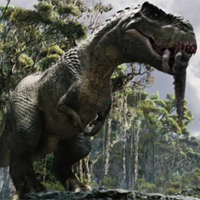Post by Z451 on May 22, 2017 18:21:25 GMT

Vastatosaurus Rex
Vastatosaurus rex ("ravager lizard king") was an extremely large species of theropod dinosaur that was found on Skull Island prior to it's collapse.
The animal is described in the book "The World of Kong: A Natural History of Skull Island" (2005).
Vastatosaurus rex was an antagonist in King Kong.
An evolved descendant of the ancient Tyrannosaurus rex that lived after the Cretaceous, this species was the largest terrestrial predator found on Skull Island, reaching a height of over 20 feet (6.1 meters) and measuring up to 50 feet (15.2 meters) long.
The weight of the Vastatosaurus rex probably outclassed its predecessor, Tyrannosaurus rex.
Despite their size, they could break into surprising bursts of speed, often achieving speeds of 25 mph over short distances.
Vastatosaurus rex was fictionally hypothesized to be what the Tyrannosaurus rex could have become if it were allowed to evolve unabated after the past 65 million years.
Their advancement could be due to the vast abundance of large prey, the rarely changing environment of the lush Skull Island, and warm humid climate similar to the Cretaceous.
Like their prehistoric relatives, V. rexes had little competition for their position as top predators.
The Vastatosaurus had developed many unique features over the 65 million year time gap, but they still retained several recognizable similarities to their Cretaceous cousins.
Vastatosaurs had large heads that evolved over time to be thicker and bulkier, giving them extra protection, and its overall leather-like hide reduced physical injury from hunting if its choice of prey was smaller than itself.
Its gaping mouth was its main tool for hunting, filled with large teeth that were constantly being regrown to replace those lost in conflict.
Unlike most theropods, the Vastatosaurus had overlapping peg-like teeth.
Their heads were shorter and more compact than that of their ancestors, intensely reinforced with thick bone.
As the primary weapon of the animal, an individual Vastatosaurus head was often distinctive, being covered with scars and callouses from rivals.
Abnormal bone growths from old battles with prey, other predators, rivals, or even mates were not uncommon.
A narrow, short rib cage and a large gap between the ribs and hips allowed V. rexes surprising flexibility for animals of their size, a necessary adaptation to survive among the towering trees and broken terrain of Skull Island.
The Vastatosaurus rex had a limited but notable ability to problem solve.
The species displayed enough ingenuity to knock down large objects obstructing its path toward smaller prey that tried to conceal themselves between them; if such prey still held its interest, the dinosaur would also try it.
Links:
King Kong Wiki
Godzilla Wiki
Copyright Owner
Universal Studios
Record:
W:
L:
The animal is described in the book "The World of Kong: A Natural History of Skull Island" (2005).
Vastatosaurus rex was an antagonist in King Kong.
An evolved descendant of the ancient Tyrannosaurus rex that lived after the Cretaceous, this species was the largest terrestrial predator found on Skull Island, reaching a height of over 20 feet (6.1 meters) and measuring up to 50 feet (15.2 meters) long.
The weight of the Vastatosaurus rex probably outclassed its predecessor, Tyrannosaurus rex.
Despite their size, they could break into surprising bursts of speed, often achieving speeds of 25 mph over short distances.
Vastatosaurus rex was fictionally hypothesized to be what the Tyrannosaurus rex could have become if it were allowed to evolve unabated after the past 65 million years.
Their advancement could be due to the vast abundance of large prey, the rarely changing environment of the lush Skull Island, and warm humid climate similar to the Cretaceous.
Like their prehistoric relatives, V. rexes had little competition for their position as top predators.
The Vastatosaurus had developed many unique features over the 65 million year time gap, but they still retained several recognizable similarities to their Cretaceous cousins.
Vastatosaurs had large heads that evolved over time to be thicker and bulkier, giving them extra protection, and its overall leather-like hide reduced physical injury from hunting if its choice of prey was smaller than itself.
Its gaping mouth was its main tool for hunting, filled with large teeth that were constantly being regrown to replace those lost in conflict.
Unlike most theropods, the Vastatosaurus had overlapping peg-like teeth.
Their heads were shorter and more compact than that of their ancestors, intensely reinforced with thick bone.
As the primary weapon of the animal, an individual Vastatosaurus head was often distinctive, being covered with scars and callouses from rivals.
Abnormal bone growths from old battles with prey, other predators, rivals, or even mates were not uncommon.
A narrow, short rib cage and a large gap between the ribs and hips allowed V. rexes surprising flexibility for animals of their size, a necessary adaptation to survive among the towering trees and broken terrain of Skull Island.
The Vastatosaurus rex had a limited but notable ability to problem solve.
The species displayed enough ingenuity to knock down large objects obstructing its path toward smaller prey that tried to conceal themselves between them; if such prey still held its interest, the dinosaur would also try it.
Links:
King Kong Wiki
Godzilla Wiki
Copyright Owner
Universal Studios
Record:
W:
L:

